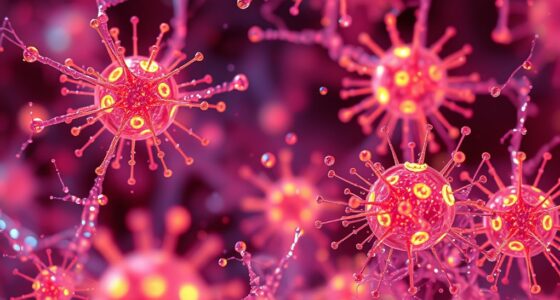Nanodetoxification uses specially designed nanoparticles that bind to harmful toxins efficiently, thanks to their tiny size and high surface area. These particles can target and remove contaminants from your body or environment more precisely than traditional methods. By modifying nanoparticle surfaces, scientists improve their ability to capture specific toxins while reducing side effects. While promising, safety concerns like potential toxicity need ongoing research. To discover how these innovative techniques work and their future potential, keep exploring this exciting topic.
Key Takeaways
- Nanoparticles under 100 nm have high surface area and customizable surface chemistry, enabling targeted and efficient toxin binding.
- Surface functionalization enhances nanoparticle stability and specificity, improving their ability to capture harmful substances.
- Metal-based and carbon nanotube nanoparticles can penetrate biological barriers, facilitating detoxification at cellular levels.
- Responsible nanodetoxification requires safety assessments, regulation, and handling protocols to minimize environmental and health risks.
- Ongoing research focuses on designing smarter, biocompatible nanoparticles for faster, safer, and more effective toxin removal.
Understanding Nanoparticles and Their Properties
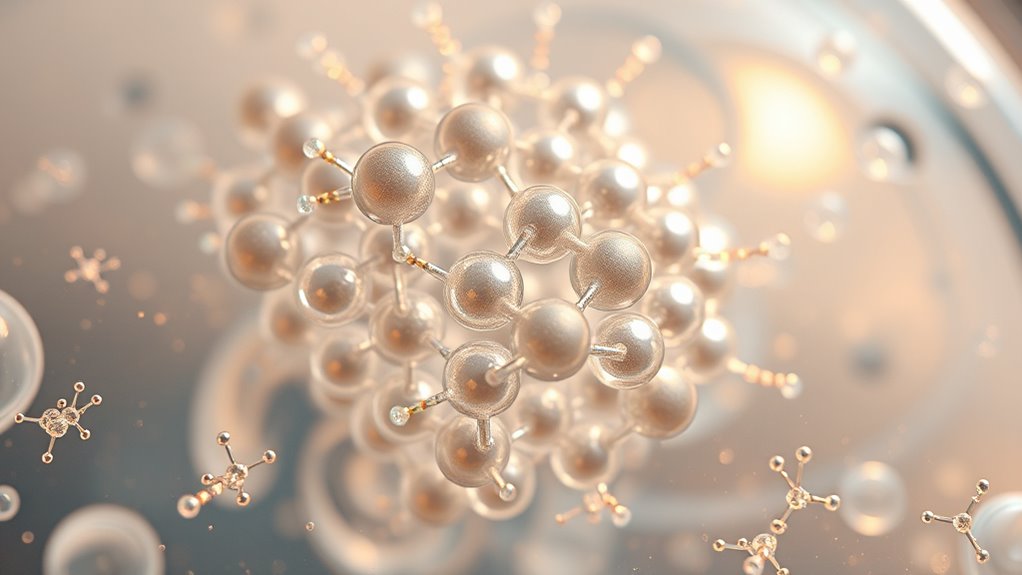
Nanoparticles are tiny particles measuring less than 100 nanometers, which gives them unique physical and chemical properties that differ markedly from their bulk counterparts. This small size allows for precise control during nanoparticle synthesis, enabling you to tailor their characteristics for specific applications. Surface functionalization plays a vital role, as it involves attaching molecules to the nanoparticle surface to enhance stability, selectivity, and reactivity. By modifying surfaces, you can improve how nanoparticles interact with toxins or pollutants, making them more effective in nanodetoxification. Understanding these fundamental properties helps you design nanoparticles that are highly efficient at capturing and removing harmful substances, leveraging their high surface area and customizable surface chemistry for targeted detoxification processes. In addition, knowledge of surface modification techniques can further optimize nanoparticle performance in detoxification applications.
The Science Behind Nanodetoxification

You can see how nanoparticles bind to toxins, making it easier for your body to remove harmful substances. This process considerably boosts detox efficiency compared to traditional methods. By understanding this science, you’ll appreciate how nanodetoxification offers a targeted and effective approach. Additionally, vetted portable detox solutions demonstrate the practical applications of nanoparticle technology in health and wellness.
Nanoparticle Toxin Binding
Understanding how nanodetoxification works hinges on the ability of nanoparticles to bind toxins effectively. Surface modification plays a key role by enhancing binding sites, making toxins stick more efficiently. Smaller particle size increases surface area, providing more contact points for toxins to attach. This combination improves detoxification performance. To illustrate:
| Surface Modification | Particle Size | Toxin Binding Efficiency |
|---|---|---|
| Adds functional groups | Nanoscale | Higher binding affinity |
| Improves specificity | Reduces size | Faster toxin removal |
| Enhances stability | Increases surface area | Better detox results |
| Customizes interactions | Optimized size | Selective toxin capture |
Enhanced Detox Efficiency
Enhanced detox efficiency in nanodetoxification relies on the ability of nanoparticles to rapidly and selectively bind a wide range of toxins. This efficiency depends heavily on optimized nanoparticle synthesis, which creates particles with high surface area and tailored properties for toxin capture. By controlling size, shape, and surface chemistry during synthesis, you can improve how effectively nanoparticles interact with and neutralize toxins. The enhanced detoxification efficiency means faster removal of harmful substances and better overall detox results. Precise nanoparticle synthesis ensures these particles have the right characteristics to maximize binding capacity and minimize off-target effects. As a result, nanodetoxification becomes a more powerful, targeted method for cleansing toxins from the body or environment, offering faster, safer, and more effective detox solutions.
How Toxins Accumulate in the Body

Toxins enter your body through various sources, including contaminated air, processed foods, and personal care products. Once inside, they can accumulate through bioaccumulation processes, where toxins build up faster than your body can remove them. Certain chemicals have environmental persistence, meaning they resist breakdown and stay in your system longer. Over time, this persistence increases the risk of toxins reaching harmful levels, especially if exposure continues. Your body’s natural detox mechanisms can become overwhelmed, leading to stored toxins in fat tissues or organs. Understanding how toxins accumulate highlights the importance of minimizing exposure and using advanced detox methods, such as nanotechnology. This knowledge helps you take control of your health and reduce the long-term effects of environmental toxins.
Mechanisms of Nanoparticle Toxin Capture
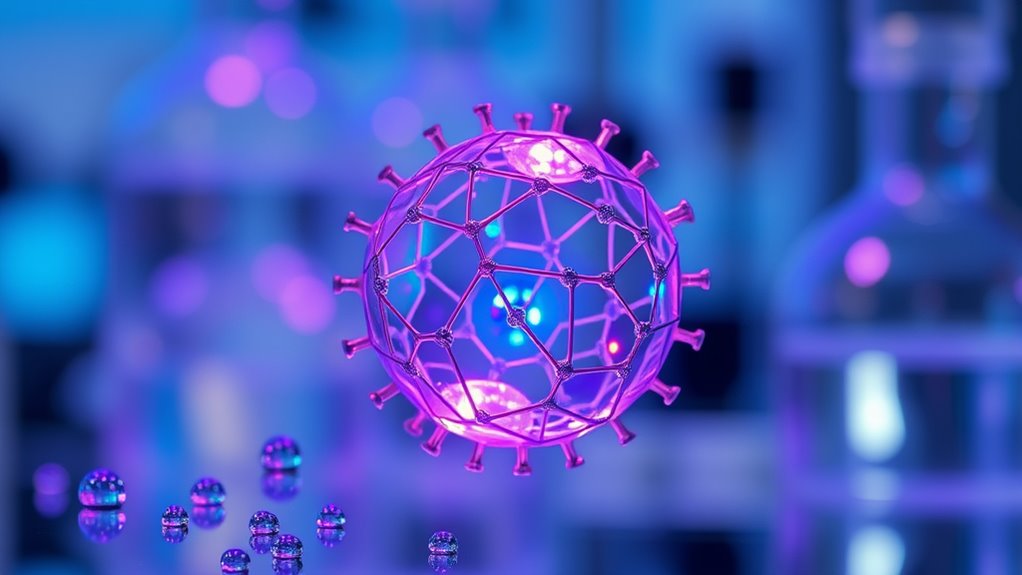
Nanoparticles are engineered to target and neutralize toxins effectively within the body. Their surface charge plays a pivotal role in this process, influencing how well they attract and bind to specific toxins. For example, positively charged nanoparticles can attract negatively charged toxins through electrostatic interactions, enhancing capture efficiency. Binding affinity refers to the strength of the interaction between the nanoparticle and the toxin; higher affinity means the toxin is more likely to stay attached. You can optimize these mechanisms by adjusting surface charge and chemistry, ensuring toxins are effectively captured and removed. This targeted approach allows nanoparticles to act like molecular magnets, selectively binding harmful substances and preventing their spread or absorption into tissues. Additionally, understanding the vibrational state of nanoparticles can improve their ability to attract and bind toxins more efficiently.
Types of Nanoparticles Used in Detoxification
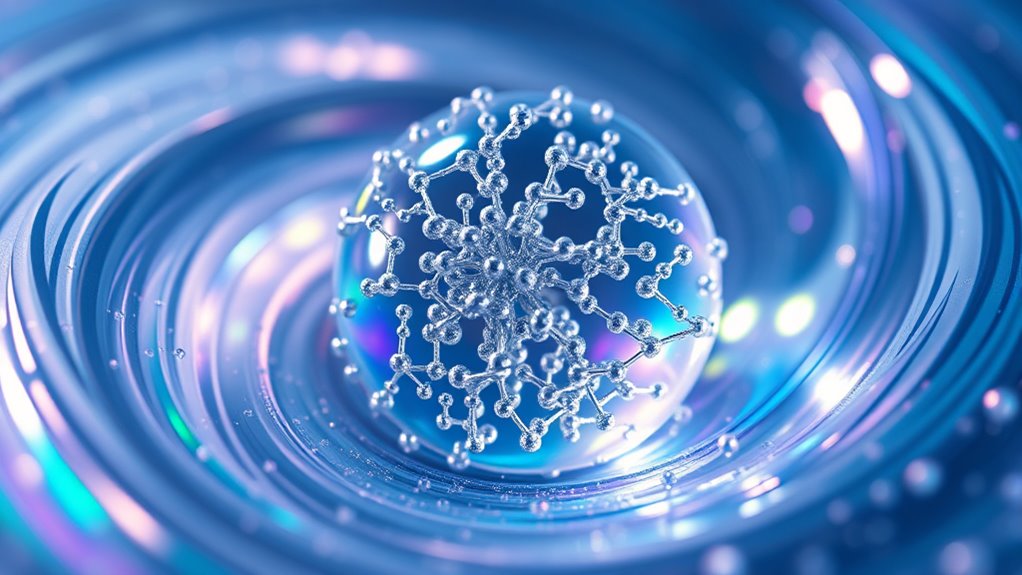
Several types of nanoparticles are employed in detoxification therapies, each designed to target specific harmful substances effectively. These include metal-based nanoparticles like gold and silver, carbon nanotubes, and silica nanoparticles. The process begins with nanoparticle synthesis, where different methods produce particles with desired sizes and shapes. Surface modification plays an essential role in enhancing their targeting ability and biocompatibility. By attaching functional groups or coatings, you can improve their affinity for particular toxins and reduce potential side effects. For example, coating nanoparticles with biocompatible materials allows them to circulate safely in the body while capturing toxins. Choosing the right nanoparticle type, along with precise synthesis and surface modification techniques, guarantees effective toxin removal and minimizes adverse reactions.
Advantages Over Traditional Detox Methods

Nanodetoxification offers significant advantages over traditional methods by providing targeted, efficient, and minimally invasive toxin removal. Unlike conventional detox protocols, which often involve broad approaches like fasting or supplements, nanoparticle synthesis enables precise design of particles that seek out specific toxins. This precision enhances detoxification efficiency, reducing the time and effort needed. Additionally, nanoparticles can penetrate cellular barriers more effectively, making detox processes less invasive and more comfortable. Traditional methods may cause side effects or incomplete detox, but nanotechnology allows for tailored detox protocols that optimize removal while minimizing risks. Moreover, understanding the mechanisms of nanoparticle delivery is crucial for developing effective nanodetoxification strategies. These benefits make nanodetoxification a promising alternative, offering faster, safer, and more effective detox solutions compared to conventional approaches.
Potential Risks and Safety Considerations
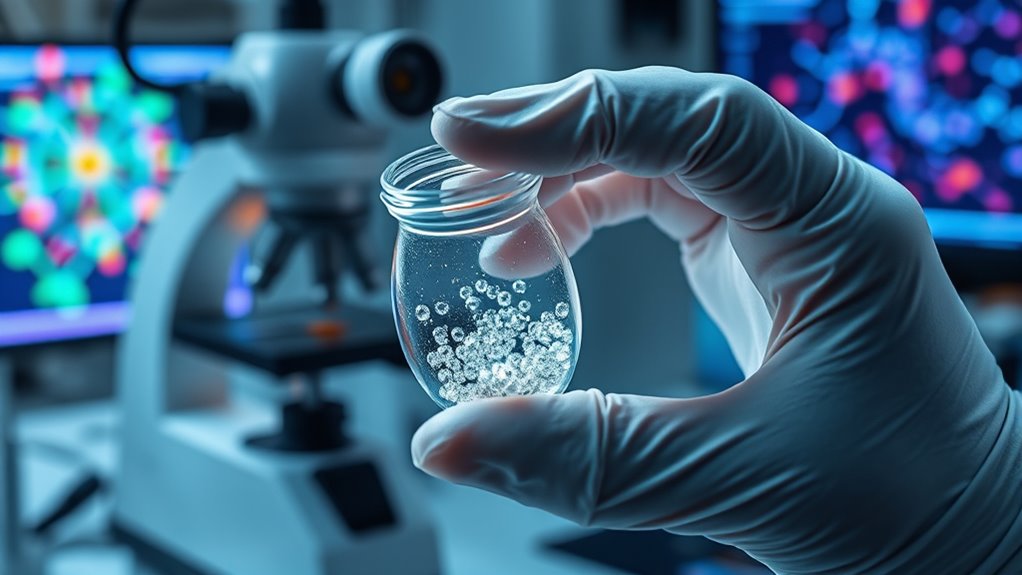
You should consider the potential toxicity of nanoparticles, as their small size might pose health and environmental risks. Long-term safety data are limited, making it hard to fully understand the effects over time. Additionally, regulatory oversight faces challenges in establishing clear guidelines for safe nanodetoxification practices. Given the emerging nature of nanotechnology, ongoing safety assessments are crucial to ensure responsible use.
Nanoparticle Toxicity Risks
While nanotechnology offers promising benefits, the potential toxicity of nanoparticles raises significant safety concerns. You need to contemplate the environmental impact, as tiny particles can enter ecosystems, affecting wildlife and water quality. Manufacturing safety is also vital, since improper handling or release of nanoparticles during production can pose health risks to workers and communities. Nanoparticles may interact unpredictably with biological systems, potentially causing cellular damage or inflammation if they accumulate in the body. Ensuring rigorous safety protocols during manufacturing and controlling nanoparticle release are essential steps to mitigate these risks. Understanding and managing these toxicity risks help protect both human health and the environment, making nanodetoxification a safer, more responsible technology.
Long-term Safety Data
Evaluating the long-term safety of nanodetoxification requires thorough understanding of potential risks that may not be immediately apparent. One key concern is nanoparticle longevity; if particles persist in the body, they could cause unforeseen effects. Long-term bioaccumulation raises questions about accumulation in organs and tissues over time. You should consider how nanoparticles break down or persist, as their stability impacts safety. Here’s a quick overview:
| Aspect | Concern | Implication |
|---|---|---|
| Nanoparticle longevity | How long particles remain active | Potential chronic exposure |
| Bioaccumulation | Accumulation in tissues | Long-term toxicity risk |
| Clearance | Elimination rates | Impact on safety over time |
| Particle stability | Resistance to degradation | Possible buildup in organs |
| Monitoring | Detecting residual nanoparticles | Ensures ongoing safety |
Understanding these factors helps you assess potential long-term risks of nanodetoxification.
Regulatory Oversight Challenges
Regulatory oversight for nanodetoxification faces significant challenges due to the complex and evolving nature of nanomaterials. You might encounter regulatory gaps that leave certain risks underregulated or misunderstood, especially as nanomaterials behave differently than their bulk counterparts. Existing policy frameworks often lack specific guidelines tailored to nanoparticles, making it difficult to assess safety and environmental impacts effectively. This lack of clear standards can hinder innovation while risking public and ecological health. You need to stay informed about ongoing efforts to update regulations and fill these gaps. Developing thorough policies that account for nanomaterial properties is essential to ensure safety without stifling technological progress. Addressing these regulatory oversight challenges is crucial for responsible and sustainable nanodetoxification practices.
Current Research and Future Developments
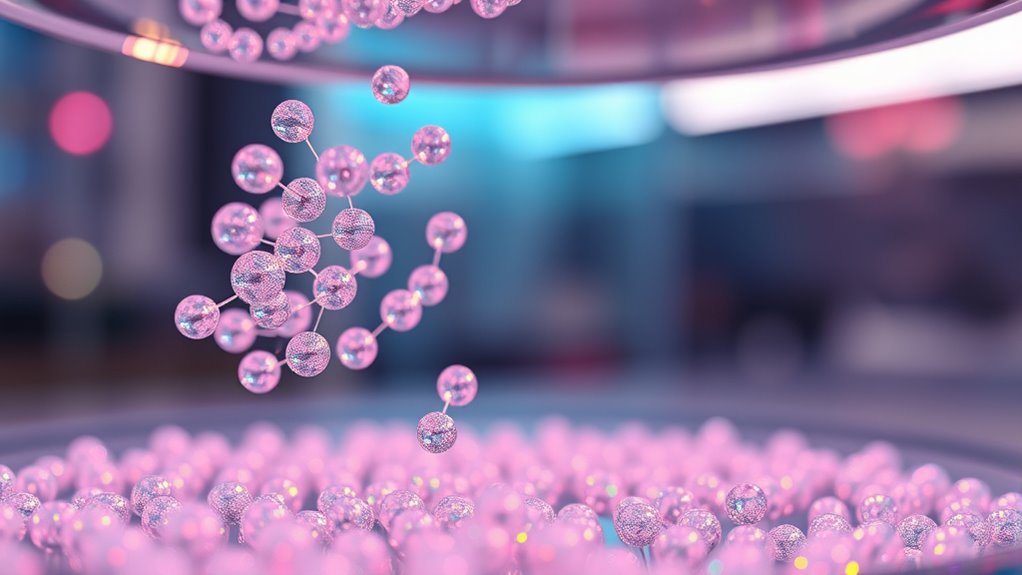
Recent research in nanodetoxification focuses on developing more efficient and targeted methods to remove harmful contaminants from the body. Advances in nanoparticle synthesis aim to create specialized particles that can bind toxins more effectively, enhancing detoxification while minimizing side effects. Researchers are also exploring ways to improve toxicity mitigation, ensuring nanoparticles are safe for human use. Innovations include surface modifications and biocompatible coatings that reduce immune responses and long-term toxicity risks. Future developments are likely to involve smarter nanoparticles capable of recognizing specific toxins and delivering detox agents precisely where needed. These efforts are driving the field toward safer, more effective detoxification solutions, ultimately making nanodetoxification a practical tool for health management and environmental cleanup. Additionally, understanding the financial impact of entertainment industries can guide funding and innovation in nanotechnology research.
Practical Applications and Ways to Incorporate Nanodetoxification

Nanodetoxification is rapidly moving from research laboratories into real-world applications, offering promising solutions for personal health and environmental remediation. To incorporate nanodetoxification effectively, you can explore nanoparticle synthesis methods tailored for specific toxins. These protocols often involve customizing particle size, surface chemistry, and functionalization to target particular pollutants. You might use nanomaterials in water treatment plants, air purification systems, or even in medical settings to detoxify harmful substances. Implementing these detoxification protocols requires understanding the ideal nanoparticle types and dosages, ensuring safety and efficiency. By integrating nanotechnology into existing processes, you can enhance toxin removal while minimizing chemical use. Staying informed about the latest synthesis techniques, safety standards, and AI security measures will maximize benefits and ensure responsible application.
Frequently Asked Questions
How Long Does Nanodetoxification Typically Take to See Results?
You might start noticing results from nanodetoxification within a few days to a few weeks. The timeframe variability depends on individual factors like your toxin levels, overall health, and the treatment plan. Some people see quick improvements, while others may require multiple sessions over several weeks. Stay consistent with your treatment and consult your specialist to tailor the process to your needs for the best results.
Are There Specific Toxins That Nanodetoxification Cannot Target Effectively?
Yes, nanodetoxification has limitations in toxin specificity due to nanoparticle size constraints. Smaller nanoparticles are more effective at targeting certain toxins, but larger or chemically complex toxins may not be effectively removed. You should be aware that some toxins, especially those bound tightly within tissues or with specific chemical properties, may require alternative detox methods. Always consult a professional to determine if nanodetoxification suits your specific toxin elimination needs.
Can Nanodetoxification Be Combined With Other Detox Methods Safely?
Did you know combining detox methods can boost toxin removal by up to 30%? You can safely pair nanodetoxification with other methods, but it’s vital to take nanoparticle safety and detox compatibility into account. Always consult a healthcare professional before combining treatments to guarantee no adverse interactions. When done correctly, integrating nanodetoxification with other approaches can enhance overall detox efficiency and support your health journey safely.
What Are the Long-Term Health Impacts of Using Nanoparticles for Detox?
You’re concerned about long-term safety, and it’s true that nanoparticle accumulation in your body could pose risks over time. While current research suggests short-term safety, the long-term health impacts remain uncertain due to potential buildup and unknown interactions. Continued studies are essential to fully understand these effects, so it’s wise to stay cautious and consult healthcare professionals before opting for nanoparticle-based detox methods for sustained health.
Is Nanodetoxification Suitable for All Age Groups and Health Conditions?
Is nanodetoxification suitable for everyone? Think of it as a tailored suit—what fits one person might not fit another. You need to take into account age considerations and health restrictions before trying it. Young children, pregnant women, or those with chronic health conditions should consult healthcare professionals, as this treatment might pose risks. Always prioritize personalized advice to ensure safety and effectiveness for your unique situation.
Conclusion
As you explore nanodetoxification, remember that “prevention is better than cure.” Nanoparticles offer a promising way to remove toxins efficiently, but always stay informed about potential risks. By understanding their science and safety, you can make smarter choices for your health. Embrace this innovative approach with caution, knowing that progress requires careful consideration. With knowledge and vigilance, nanodetoxification can be a valuable tool in safeguarding your well-being.


